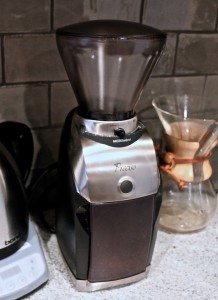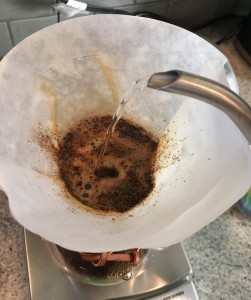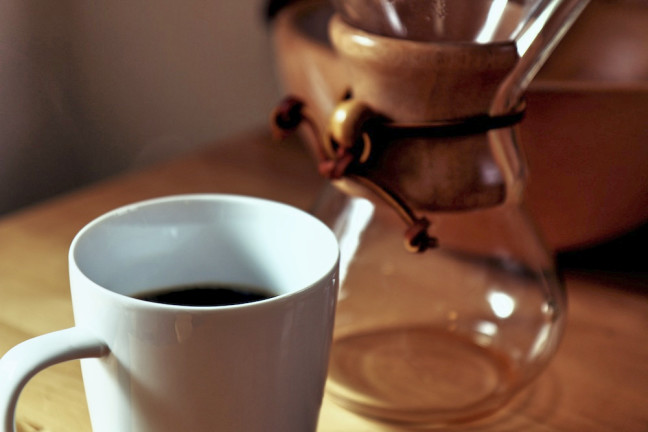You love the coffee at your local café, but you feel obligated to be at least 50% coherent and not wearing pajamas to go there. And some mornings, showers and sentences are just not happening before your first cup. To be prepared, you buy beans from the café for at-home-in-your-nighty brewing.
Problem solved. You thought.
But when you make the same coffee at home, it isn’t as good.
Listed below are what I’ve found to be “The Culprits” – the reasons why the same beans might not taste as good when brewed at home. The good news is that those cute pajamas you wear have nothing to do with it. They can stay.
The other good news: The Culprits are just variables at play in the coffee brewing process, and you can control them to brew great coffee at home any time.
The Culprits
-
Coffee-to-Water Ratio
Many underestimate the extent to which varying coffee-to-water ratios can change the flavor and body – not just the “strength” – of a cup.
There’s no “right” ratio. The ideal ratio can also vary with your brew method but in general, 1 gram of coffee to 16 grams of water is a good starting point. Find the ratio you like, and be intentional in achieving it each time.
To be precise, I use a scale to measure both my coffee and water. You can measure in other ways (e.g. 2 tablespoons of coffee for each 6 fluid ounces of water) as long as your method has sufficient precision to achieve your sweet spot ratio every time.
-
Freshness of Beans
When you buy beans from a specialty coffee shop, they should be freshly roasted (you can ask for the roast date if it’s not on the packaging). It’s best to brew within a few weeks of the roast date. If you’re not using your beans by the three-week mark, try buying in smaller amounts so your coffee is fresh.
-
The Grind
This variable may hurt at-home cups the most.
You GOT to grind just before brewing. You GOT to have a good grinder. And you GOT to have that grinder on the right setting.
So this is actually 3 variables related to grinding:
Minimize time between grinding and brewing
Grind your beans at home, just before brewing. So yes, you should really have a grinder at home. (They make great birthday presents. To yourself. Six months early…)
Use a good grinder
 Before you go birthday shopping, make sure you’re buying a good grinder. Good grinders produce grounds that are consistent in size. Bad grinders produce grounds of different sizes. When grounds are different sizes, different amounts of surface area are exposed to the water, which leads to inconsistent extraction (and less than ideal taste). To maintain even extraction across particles, we need consistency in ground size.
Before you go birthday shopping, make sure you’re buying a good grinder. Good grinders produce grounds that are consistent in size. Bad grinders produce grounds of different sizes. When grounds are different sizes, different amounts of surface area are exposed to the water, which leads to inconsistent extraction (and less than ideal taste). To maintain even extraction across particles, we need consistency in ground size.
Burr grinders (as opposed to blade grinders) are your best bet. At La Vita Dolce, we use Mahlkonig grinders. They’re beautiful, highly professional machines. They would also be overkill at home. At home, I use a smaller Baratza grinder. There are other good options out there – but by “good option” I do not mean a standard drip brewer that comes with a little built in grinding compartment thing. Don’t do it.
Set to the appropriate grind setting
The best grind setting depends on your brew method. Different brew methods have different dwell times (the period during which water is in contact with the grounds). The longer the dwell time, the coarser the grind needed.
Espresso calls for a fine grind, drip brewing calls for a coarser grind, French Press calls for an even coarser grind. You can Google your brand of grinder and brew method to find a suggested grind setting and go from there.
-
Operation of Your Brew Gadgets
 No matter how you brew your coffee, it’s important to use your brew gadgets properly. At home, I typically use the pour over method, which is a type of drip brewing. My equipment: scale, Baratza grinder, Chemex coffeemaker, filter, kettle. Simple, but I still need to operate my gadgets correctly (e.g. saturate grounds evenly when pouring water, don’t pour too much water at once). Ask Siri for tips on how to use your preferred equipment.
No matter how you brew your coffee, it’s important to use your brew gadgets properly. At home, I typically use the pour over method, which is a type of drip brewing. My equipment: scale, Baratza grinder, Chemex coffeemaker, filter, kettle. Simple, but I still need to operate my gadgets correctly (e.g. saturate grounds evenly when pouring water, don’t pour too much water at once). Ask Siri for tips on how to use your preferred equipment.
-
Water
Again, here we actually have two factors that I combined into one to make this list look shorter and get you to read this far.
Bad water = bad coffee
Ever made coffee using tap water at the beach? Not so pleasant. At La Vita Dolce, we have multiple filtration systems that are regularly changed. At home, you can use bottled water or filtered tap water (assuming you remember the last time you changed that water filter…).
Temperature affects extraction
You want your water to be just below boiling at 195-205 degrees F when brewing. Unless you’re cold brewing to make Dolce Nitro…
And there we have it: how you can make coffee that tastes like it was brewed in your favorite café, all while avoiding human interaction and normal clothes. Dreams do come true.
Keep in mind that if you’re using a different brew method than used at the café, your coffee is probably going to taste different. But the ins and outs of various brew methods we will save for another time…

